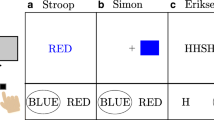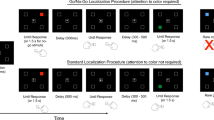Summary
As is indicated by the Simon effect, choice reactions can be carried out faster when the response corresponds spatially to the stimulus, even if the stimulus location is irrelevant to the task. In Experiments 1–4 the relationships between the Simon effect and stimulus eccentricity, signal quality, and signal-background contrast are investigated. The Simon effect was found to interact with all of these factors, at least when manipulated blockwise. These results are at odds with previous results and are difficult to interpret from an additive-factor-method view. An alternative interpretation is suggested that attributes the results to the temporal relationship between the processing of the relevant stimulus information and stimulus location. The assumption is that a decrease in the Simon effect is caused by every experimental manipulation that markedly increases the temporal distance between the coding of the relevant stimulus information and that of the irrelevant stimulus location. This assumption was tested in Experiment 5 in a more direct way. The stimuli were built up on a screen over time, so that the temporal distance between the presence of location and identity information could be controlled experimentally. The results provide further support for a temporal-delay interpretation of interactions between irrelevant stimulus-response correspondence and factors that affect early stages of information processing.
Similar content being viewed by others
References
Acosta, E., & Simon, J. R. (1976). The effect of irrelevant information on the stages of processing. Journal of Motor Behavior, 8, 181–187.
Brebner, J., Shephard, M., & Cairney, P. (1972) Spatial relationships and S -R compatibility. Acta Psychologica, 36, 1–15.
Gunia, H. (1987). Identifikation verschiedener Kompatibilitätstypen bei komplexen Wahlreaktionsexperimenten. Unpublished master's thesis, Darmstadt, Germany.
Hasbroucq, T., & Guiard, Y. (1991). Stimulus-response compatibility and the Simon effect: Toward a conceptual clarification. Journal of Experimental Psychology: Human Perception and Performance, 17, 246–266.
Kornblum, S., Hasbroucq, T., & Osman, A. (1990). Dimensional overlap: Cognitive basis for stimulus-response compatibility — A model and taxonomy. Psychological Review, 97, 253–270.
Lowe, D. G. (1979). Strategies, context, and the mechanism of response inhibition. Memory & Cognition, 7, 382–389.
McCann, R. S., & Johnston, J. C. (1992). Locus of the single-channel bottleneck in dual-task interference. Journal of Experimental Psychology: Human Perception and Performance, 18, 471–484.
Miller, J. (1982). Discrete versus continuous stage models of human information processing: In search of partial output. Journal of Experimental Psychology: Human Perception and Performance, 8, 273–296.
Miller, J. (1988). Discrete and continuous models of human information processing: Theoretical distinctions and empirical results. Acta Psychologica, 67, 191–257.
Morton, J. (1969). Interaction of information in word recognition. Psychological Review, 76, 165–178.
Neill, W. T., & Westberry, R. L. (1987). Selective attention and the suppression of cognitive noise. Journal of Experimental Psychology: Learning, Memory, and Cognition, 13, 327–334.
Nicoletti, R., & Umilta, C. (1989). Splitting visual space with attention. Journal of Experimental Psychology: Human Perception and Performance, 15, 164–169.
Poffenberger, A. T. (1912). Reaction time to retinal stimulation with special reference to the time lost in conduction through nerve centers. Archives of Psychology, 23, 1–73.
Prinz, W. (1972). Reaktionszeit-Fraktionierung durch Varianzanalyse? Archiv für Psychologie, 124, 240–252.
Rabbitt, P. M. (1967). Signal discriminability, S-R compatibility and choice reaction time. Psychonomic Science, 7, 419–420.
Sanders, A. F. (1980). Stage analysis of reaction processes. In G. E. Stelmach & J. Requin (Eds.), Tutorials in motor behavior (pp. 331–354). Amsterdam: North-Holland.
Sanders, A. F. (1990). Issues and trends in the debate on discrete vs. continuous processing of information. Acta Psychologica, 74, 123–167.
Shwartz, S. P., Pomerantz, J. R., & Egeth, H. E. (1977). State and process limitations in information processing: An additive factors analysis. Journal of Experimental Psychology: Human Perception and Performance, 3, 402–410.
Simon, J. R. (1982). Effect of an auditory stimulus on the processing of a visual stimulus under single- and dual-task conditions. Acta Psychologica, 51, 61–73.
Simon, J. R., & Acosta, E. (1982). Effect of irrelevant information on the processing of relevant information: Facilitation and/or interference? The influence of experimental design. Perception & Psychophysics, 31, 383–388.
Simon, J. R., Acosta, E., Mewaldt, S. P., & Speidel, C. R. (1976). The effect of an irrelevant directional cue on choice reaction time: Duration of the phenomenon and its relation to stages of processing. Perception & Psychophysics, 19, 16–22.
Simon, J. R., & Berbaum, K. (1990). Effect of conflicting cues on information processing: The ‘Stroop effect’ vs. the ‘Simon effect’. Acta Psychologica, 73, 159–170.
Simon, J. R., & Craft, J. L. (1970). Effect of an irrelevant auditory stimulus on visual choice reaction time. Journal of Experimental Psychology, 86, 272–274.
Simon, J. R., Craft, J. L., & Small, A. M. Jr., (1970). Manipulating the strength of a stereotype: Interference effects in an auditory information-processing task. Journal of Experimental Psychology, 86, 63–68.
Simon, J. R., Craft, J. L., & Small, A. M. Jr., (1971). Reactions toward the apparent source of an auditory stimulus. Journal of Experimental Psychology, 89, 203–206.
Simon, J. R., Mewaldt, S. P., Acosta, E., & Hu, J. (1976). Processing auditory information: Interaction of two population stereotypes. Journal of Applied Psychology, 61, 354–358.
Simon, J. R., & Pouraghabagher, A. R. (1978). The effect of aging on the stages of processing in a choice reaction time task. Journal of Gerontology, 33, 553–561.
Simon, J. R., & Rudell, A. P. (1967). Auditory S-R compatibility: The effect of an irrelevant cue on information processing. Journal of Applied Psychology, 51, 300–304.
Stanovich, K. E., & Pachella, R. G. (1977). Encoding, stimulus-response compatibility, and stages of processing. Journal of Experimental Psychology: Human Perception and Performance, 3, 411–421.
Sternberg, S. (1969). The discovery of processing stages: Extensions of Donders' method. Acta Psychologica, 30, 276–315.
Stoffels, E. J., Van der Molen, M. W., & Keuss, P. J. G. (1985). Intersensory facilitation and inhibition: Immediate arousal and location effects of auditory noise on visual choice reaction time. Acta Psychologica, 58, 45–62.
Stoffels, E. J., Van der Molen, M. W., & Keuss, P. G. J. (1989). An additive factor analysis of the effect(s) of location cues associated with auditory stimuli on stages of information processing. Acta Psychologica, 70, 161–197.
Stoffer, T. H. (1991). Attentional focussing and spatial stimulus-response compatibility. Psychological Research, 53, 127–135.
Taylor, D. A. (1976). Stage analysis in reaction time. Psychological Bulletin, 83, 161–191.
Tipper, S. P., MacQueen, G. M., & Brehaut, J. C. (1988). Negative priming between response modalities: Evidence for the central locus of inhibition in selective attention. Perception & Psychophysics, 43, 45–52.
Tsal, Y. (1983). Movements of attention across the visual field. Journal of Experimental Psychology: Human Perception and Performance, 9, 523–530.
Umilta, C., & Liotti, M. (1987). Egocentric and relative spatial codes in S -R compatibility. Psychological research, 49, 81–90.
Van der Heijden, A. H. C. (1981). Short-term visual information forgetting. London: Routledge & Kegan Paul.
Van Duren, L. L., & Sanders, A. F. (1988). On the robustness of the additive factor stage structure in blocked and mixed choice reaction designs. Acta Psychologica, 69, 83–94.
Verfaellie, M., Bowers, D., & Heilman, K. M. (1988). Attentional factors in the occurrence of stimulus-response compatibility effects. Neuropsychologia, 26, 435–444.
Wallace, R. J. (1971). S-R compatibility and the idea of a response code. Journal of Experimental Psychology, 88, 354–360.
Zachay, A. (1991). Diskrete und kontinuierliche Informationsverarbeitungsmodelle zur Erklärung von Reiz-Reactions-Inkompatibilitäten: Evidenz für einen Antwortkonflikt beim Simon-Effect. Unpublished master's thesis, Tübingen, Germany.
Author information
Authors and Affiliations
Rights and permissions
About this article
Cite this article
Hommel, B. The relationship between stimulus processing and response selection in the Simon task: Evidence for a temporal overlap. Psychol. Res 55, 280–290 (1993). https://doi.org/10.1007/BF00419688
Received:
Accepted:
Issue Date:
DOI: https://doi.org/10.1007/BF00419688




